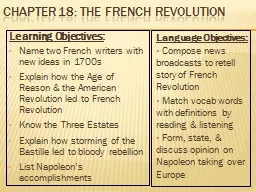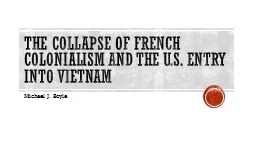PPT-Chapter 6 French Colonialism
Author : conchita-marotz | Published Date : 2018-10-31
Exploring the Mississippi French wanted to expand their trading area by finding passage to China or the Indies Northwest Passage In 1673 Joliet and Marquette left
Presentation Embed Code
Download Presentation
Download Presentation The PPT/PDF document "Chapter 6 French Colonialism" is the property of its rightful owner. Permission is granted to download and print the materials on this website for personal, non-commercial use only, and to display it on your personal computer provided you do not modify the materials and that you retain all copyright notices contained in the materials. By downloading content from our website, you accept the terms of this agreement.
Chapter 6 French Colonialism: Transcript
Download Rules Of Document
"Chapter 6 French Colonialism"The content belongs to its owner. You may download and print it for personal use, without modification, and keep all copyright notices. By downloading, you agree to these terms.
Related Documents














![[PDF READ ONLINE] Dahl\'s Law Dictionary: French to English/English to French an Annotated](https://thumbs.docslides.com/1019656/pdf-read-online-dahl-s-law-dictionary-french-to-english-english-to-french-an-annotated-legal.jpg)